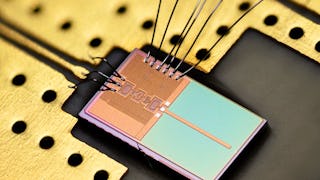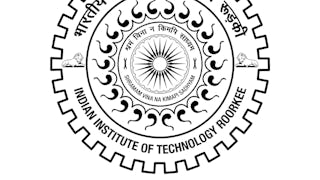Dieser einzigartige Master-Level-Kurs vermittelt Ihnen fundiertes Wissen über Mikrowellentechnik und Antennen. Der Kurs kombiniert sowohl passive und aktive Mikrowellenschaltungen als auch Antennensysteme. Zukünftige Anwendungen, wie die drahtlose Kommunikation im Millimeterwellenbereich (5G/Beyond-5G) oder das Kfz-Radar, erfordern Experten, die hochintegrierte Antennensysteme, die sowohl Antennen als auch Mikrowellenelektronik umfassen, mitentwickeln können. Wir vermitteln Ihnen die erforderlichen theoretischen Grundlagen sowie praktische Erfahrungen mit modernsten Design-Tools. Die Web-Vorlesungen werden durch zahlreiche Online-Quizze unterstützt, in denen Sie die theoretischen Grundlagen üben können. Darüber hinaus bieten wir Ihnen praktische Erfahrungen in einer Design-Challenge, in der Sie lernen, wie man Mikrowellenschaltungen und Antennen entwirft. Während des gesamten Kurses werden Sie an der Design-Challenge arbeiten, bei der Sie ein komplettes aktives Phased-Array-System entwerfen, einschließlich Antennen, Beamformer und Verstärker. Der Kurs wird durch ein vom Dozententeam geschriebenes Buch unterstützt, das den Studenten zur Verfügung gestellt wird. Nach Abschluss des Kurses kann ein Zertifikat erworben werden (5 ECTS), das Sie bei der Aufnahme eines vollständigen MSc-Programms an der Technischen Universität Eindhoven verwenden können.



(138 Bewertungen)
Empfohlene Erfahrung
Was Sie lernen werden
Modul 1: Einführung in den Kurs, einschließlich einer Übersicht über Anwendungen und Trends.
Modul 2: Passive Mikrowellenschaltungen, die auf Übertragungsleitungen basierende Schaltungen einschließlich Impedanzanpassung, Leistungskombinatoren und Filter umfassen.
Modul 3: Antennentheorie. Hier erhalten Sie eine Einführung in die Antennentheorie, einschließlich Phased Arrays.
Modul 4: Aktive Mikrowellenschaltungen. Erweiterung in Richtung Verstärker, einschließlich rauscharmer Verstärker.
Kompetenzen, die Sie erwerben
- Kategorie: Technische Analyse
- Kategorie: Elektroingenieurwesen
- Kategorie: Angewandte Mathematik
- Kategorie: Drahtlose Netzwerke
- Kategorie: Physik
- Kategorie: Engineering Design Prozess
- Kategorie: Simulation und Simulationssoftware
- Kategorie: Elektronische Systeme
- Kategorie: Mathematische Modellierung
Wichtige Details

Zu Ihrem LinkedIn-Profil hinzufügen
29 Aufgaben
Erfahren Sie, wie Mitarbeiter führender Unternehmen gefragte Kompetenzen erwerben.


Erwerben Sie ein Karrierezertifikat.
Fügen Sie diese Qualifikation zur Ihrem LinkedIn-Profil oder Ihrem Lebenslauf hinzu.
Teilen Sie es in den sozialen Medien und in Ihrer Leistungsbeurteilung.

In diesem Kurs gibt es 9 Module
In diesem kurzen Video stellen sich die Dozenten vor und geben einen allgemeinen Überblick über den Umfang des Kurses. Die Dozenten haben alle einen soliden akademischen und industriellen Hintergrund und sind in das Center for Wireless Technology Eindhoven (CWT/e) der Technischen Universität Eindhoven in den Niederlanden eingebettet.
Das ist alles enthalten
1 Video
In Woche 1 werden wir Ihnen eine Einführung in den Kurs geben, einschließlich eines Überblicks über die Anwendungen (Modul 1). Darüber hinaus beginnen wir mit passiven Mikrowellenschaltungen (Modul 2), indem wir die Theorie der Übertragungsleitungen vorstellen. Wir stellen Ihnen auch die Design-Challenge vor, bei der Sie Ihr eigenes 4-Kanal-Phased-Array-System einschließlich Beamformer und aktiver Mikrowellenelektronik entwickeln. Außerdem werden wir Ihnen zeigen, wie Sie das Open-Source-Design-Tool QUCS verwenden. Wir werden dieses Tool für das Design von passiven und aktiven Mikrowellenschaltungen verwenden.
Das ist alles enthalten
6 Videos7 Lektüren3 Aufgaben2 Diskussionsthemen
In Woche 2 werden wir mit Passive Microwave Circuits (Modul 2) fortfahren, indem wir das Konzept der Mikrowellennetzwerke einführen. Wir werden dieses Konzept bei der Analyse von Leistungskombinierern anwenden. Darüber hinaus beginnen Sie Ihre Design-Herausforderung mit dem Entwurf eines 4-Kanal-Beamformer-Netzwerks.
Das ist alles enthalten
3 Videos4 Lektüren3 Aufgaben1 peer review2 Diskussionsthemen
In Woche 3 werden wir unsere Reise zu passiven Mikrowellenschaltungen (Modul 2) abschließen, indem wir zunächst das Smith-Diagramm vorstellen und es für den Entwurf von Anpassungsschaltungen anwenden. Anschließend zeigen wir Ihnen, wie Sie Mikrowellenfilter entwerfen können.
Das ist alles enthalten
4 Videos4 Lektüren4 Aufgaben1 Diskussionsthema
In Woche 4 beginnen wir mit der Antennentheorie (Modul 3) und führen in das Konzept der Antennen ein, indem wir uns mit den wichtigsten Eigenschaften von Antennen beschäftigen, darunter Richtwirkung, Antennengewinn und Eingangsimpedanz. Wir werden zeigen, wie diese Parameter verwendet werden können, um die Reichweite eines drahtlosen Systems oder eines Radars zu bestimmen. Als erstes reales Antennenkonzept werden wir Phased-Array-Antennen vorstellen. Darüber hinaus wird die Design-Herausforderung mit einem Antennendesign fortgesetzt. Dazu gehört auch eine Einführung in das Antennendesign CST.
Das ist alles enthalten
5 Videos6 Lektüren5 Aufgaben1 peer review2 Diskussionsthemen
In dieser Woche wird das echte, theoretische Antennengerüst für den harten Kern vorgestellt. Ausgehend von den Maxwell'schen Gleichungen werden wir den allgemeinen Ausdruck für die abgestrahlten Felder einer beliebigen Antennenkonfiguration herleiten. Der Rahmen wird auf elektrische Dipol- und Drahtantennen angewendet. Darüber hinaus nehmen Sie an einem Workshop teil, in dem ein hochmodernes Antennendesign-Tool vorgestellt wird.
Das ist alles enthalten
4 Videos4 Lektüren4 Aufgaben1 Diskussionsthema
In dieser Woche werden wir unseren theoretischen Rahmen mit magnetischen Quellen erweitern. Auf diese Weise können Sie den Rahmen nutzen, um Aperturantennen zu analysieren. Wir werden dies anhand der Analyse von Hornantennen, Reflektorantennen und Mikrostreifenantennen zeigen. Wir werden auch zeigen, wie Mikrostreifenantennen zur Erstellung eines Phased-Array-Systems verwendet werden können. Zum Abschluss der Woche vermitteln wir Ihnen einige Hintergrundkenntnisse über numerische Methoden. Dies wird Ihnen helfen, die grundlegenden Prinzipien der numerischen Elektromagnetik zu verstehen, die in kommerziellen Tools wie ADS und CST verwendet werden.
Das ist alles enthalten
7 Videos7 Lektüren6 Aufgaben1 Diskussionsthema
In dieser Woche werden wir die Theorie der Mikrowellenschaltungen auf aktive Schaltungen ausweiten, die Transistoren zur Realisierung von Verstärkern verwenden. Wir beginnen mit einer Einführung in die verschiedenen Definitionen, die zur Beschreibung der Verstärkung eines Verstärkers verwendet werden. In einem nächsten Schritt werden wir eine Entwurfsmethodik für rauscharme Verstärker vorstellen. Sie beginnen auch mit dem letzten Teil Ihrer Designaufgabe, indem Sie einen rauscharmen Verstärker entwerfen.
Das ist alles enthalten
4 Videos5 Lektüren2 Aufgaben1 peer review2 Diskussionsthemen
In der letzten Woche des Kurses werden wir tiefer in das Design von Mikrowellenverstärkern eintauchen, indem wir die Stabilitätsbedingungen von Verstärkern untersuchen. Wenn die Stabilität gesichert ist, kann die Leistung des Verstärkers durch die richtige Auslegung der Eingangs- und Ausgangsanpassungsschaltungen weiter optimiert werden. Zu diesem Zweck kann das Konzept der Constant-Gain-Kreise verwendet werden.
Das ist alles enthalten
4 Videos4 Lektüren2 Aufgaben1 Diskussionsthema
Dozenten



Mehr von Elektroingenieurwesen entdecken


Eindhoven University of Technology


University of Illinois Urbana-Champaign


Qualcomm Academy
Warum entscheiden sich Menschen für Coursera für ihre Karriere?




Bewertungen von Lernenden
138 Bewertungen
- 5 stars
81,15 %
- 4 stars
10,14 %
- 3 stars
2,89 %
- 2 stars
2,17 %
- 1 star
3,62 %
Zeigt 3 von 138 an
Geprüft am 25. Nov. 2022
The course helps me reinforce knowledge about antenna design, and I have applied it in my work
Geprüft am 2. Apr. 2024
I had very good Experience by solving the assignment question. This course is very much useful for my research related work towards antenna design. Thank you to the whole Coursera team.
Geprüft am 15. Aug. 2021
It is a very interesting course. I enjoyed rediscovering some topic I learned many years ago. Thanks Prof. Smolders, Prof. Leenaerts and Prof. Johannsen. Greeetings from Colombia.

Neue Karrieremöglichkeiten mit Coursera Plus
Unbegrenzter Zugang zu 10,000+ Weltklasse-Kursen, praktischen Projekten und berufsqualifizierenden Zertifikatsprogrammen - alles in Ihrem Abonnement enthalten
Bringen Sie Ihre Karriere mit einem Online-Abschluss voran.
Erwerben Sie einen Abschluss von erstklassigen Universitäten – 100 % online
Schließen Sie sich mehr als 3.400 Unternehmen in aller Welt an, die sich für Coursera for Business entschieden haben.
Schulen Sie Ihre Mitarbeiter*innen, um sich in der digitalen Wirtschaft zu behaupten.
Häufig gestellte Fragen
Der Zugang zu Vorlesungen und Aufgaben hängt von der Art Ihrer Einschreibung ab. Wenn Sie einen Kurs im Prüfungsmodus belegen, können Sie die meisten Kursmaterialien kostenlos einsehen. Um auf benotete Aufgaben zuzugreifen und ein Zertifikat zu erwerben, müssen Sie die Zertifikatserfahrung während oder nach Ihrer Prüfung erwerben. Wenn Sie die Prüfungsoption nicht sehen:
Der Kurs bietet möglicherweise keine Prüfungsoption. Sie können stattdessen eine kostenlose Testversion ausprobieren oder finanzielle Unterstützung beantragen.
Der Kurs bietet möglicherweise stattdessen die Option 'Vollständiger Kurs, kein Zertifikat'. Mit dieser Option können Sie alle Kursmaterialien einsehen, die erforderlichen Bewertungen abgeben und eine Abschlussnote erhalten. Dies bedeutet auch, dass Sie kein Zertifikat erwerben können.
Wenn Sie ein Zertifikat erwerben, erhalten Sie Zugang zu allen Kursmaterialien, einschließlich der benoteten Aufgaben. Nach Abschluss des Kurses wird Ihr elektronisches Zertifikat zu Ihrer Erfolgsseite hinzugefügt - von dort aus können Sie Ihr Zertifikat ausdrucken oder zu Ihrem LinkedIn-Profil hinzufügen. Wenn Sie die Kursinhalte nur lesen und ansehen möchten, können Sie den Kurs kostenlos besuchen.
Sie haben Anspruch auf eine vollständige Rückerstattung bis zwei Wochen nach Ihrem Zahlungsdatum oder (bei Kursen, die gerade erst begonnen haben) bis zwei Wochen nach Beginn der ersten Sitzung des Kurses, je nachdem, welcher Zeitpunkt später liegt. Sie können keine Rückerstattung erhalten, sobald Sie ein Kurszertifikat erworben haben, auch wenn Sie den Kurs innerhalb der zweiwöchigen Rückerstattungsfrist abschließen. Siehe unsere vollständigen Rückerstattungsbedingungen.
Weitere Fragen
Finanzielle Unterstützung verfügbar,
 enthalten
enthalten

